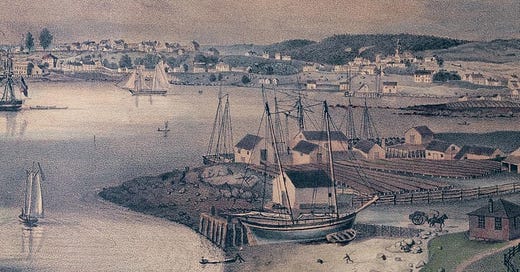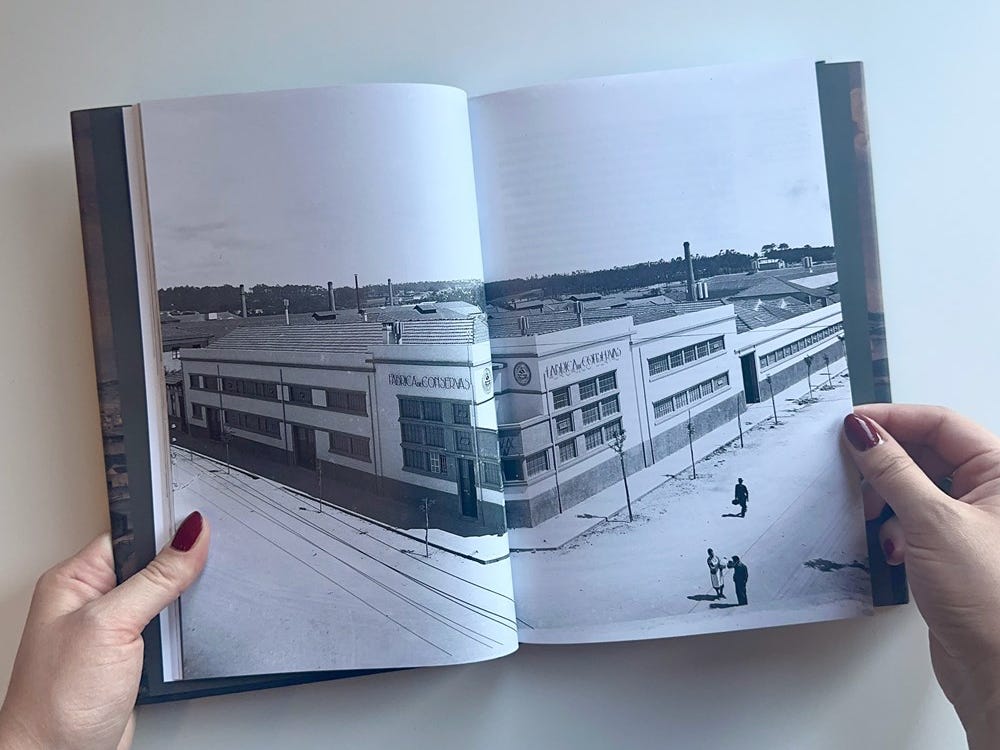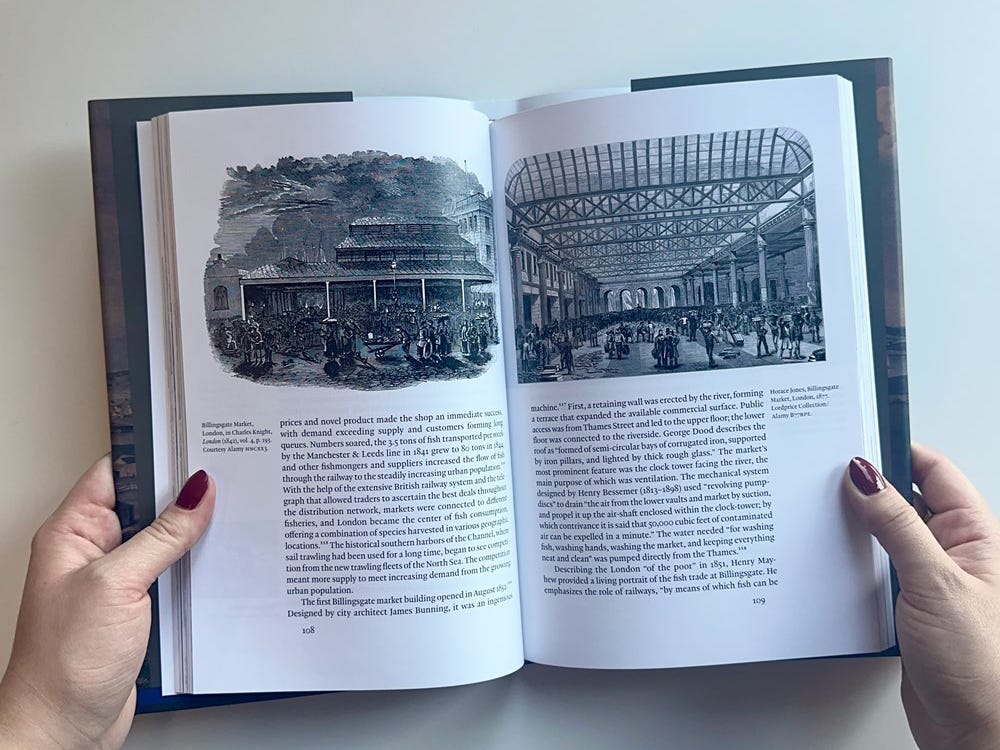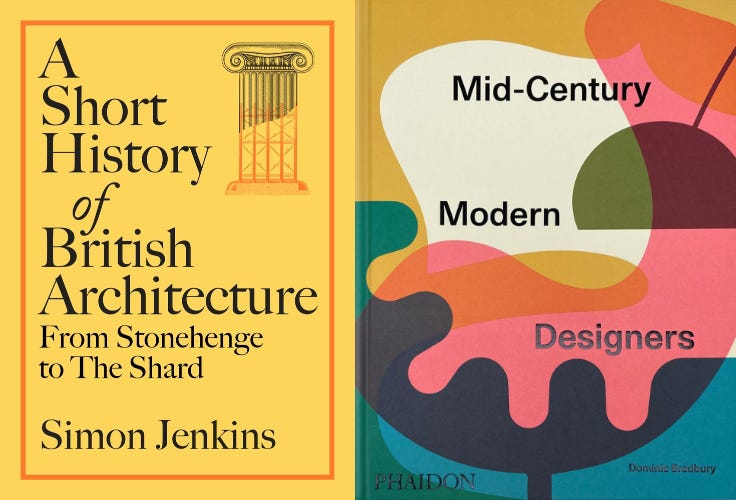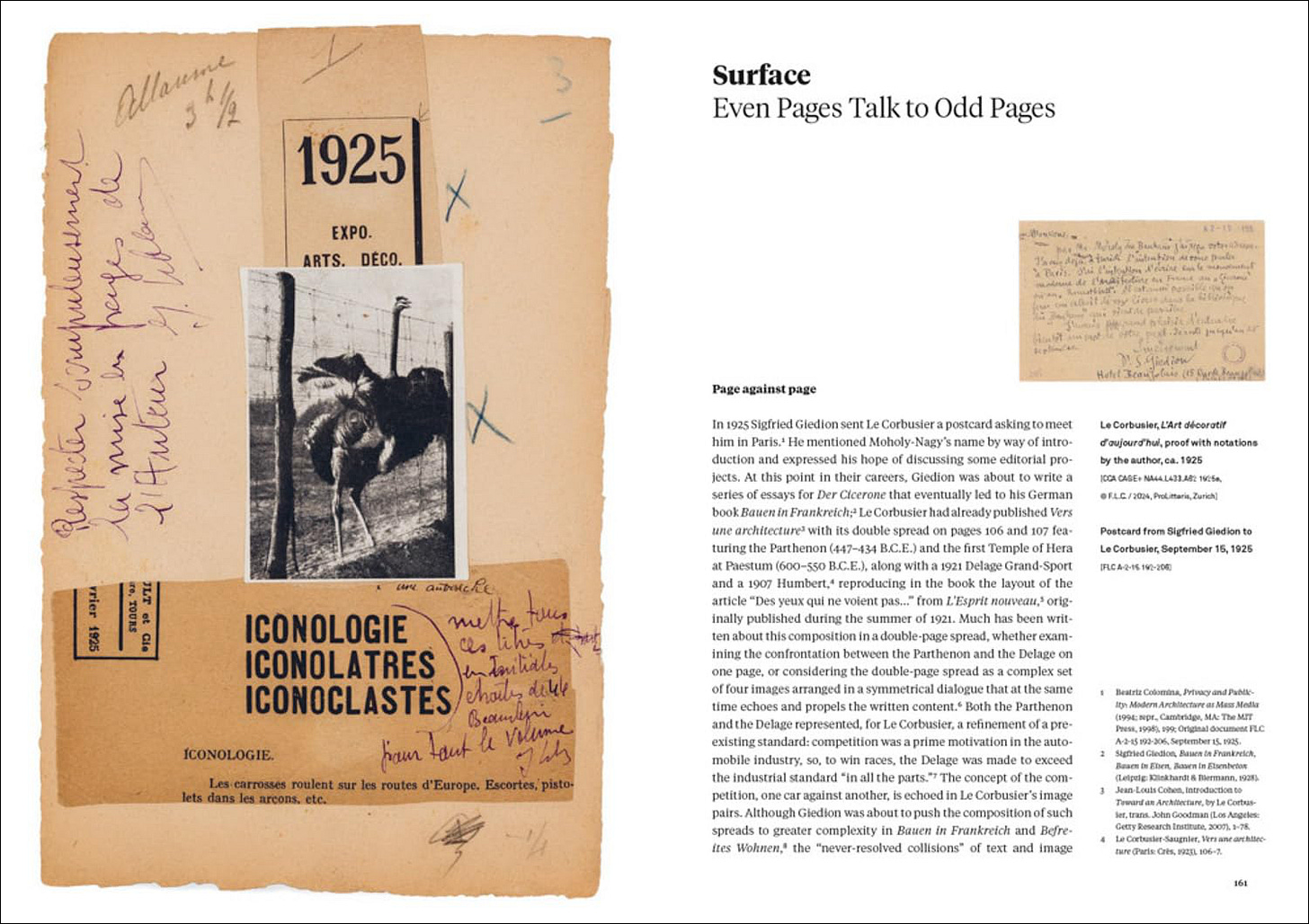This newsletter for the week of April 7 looks at a recently published book an unlikely subject: the relationship between architecture and fish. André Tavares’s Book of the Week, Architecture Follows Fish, is accompanied by one of his older books, The Anatomy of the Architectural Book, which was recently reprinted in a slightly different format. In between are the usual new releases and headlines. Happy reading!
Book of the Week:
Architecture Follows Fish: An Amphibious History of the North Atlantic, by André Tavares (Buy from The MIT Press / from Amazon / from Bookshop)
Ever since Louis Sullivan’s assertion that “form ever follows function” was extracted from its source, shortened slightly to “form follows function,” and then bandied about as the dictum underlying modern architecture in the early 20th century, architects and architectural historians have devised variations on the term to criticize modernism, counter the phrase’s dominance, or elevate the importance of other factors in determining architectural form. Most famous among the variations are Peter Blake’s Form Follows Fiasco, clearly drawing attention to modern architecture’s failings, Carol Willis’s Form Follows Finance, which shows how form was not the most importance factor influencing the form of tall buildings, and Sylvia Lavin’s Form Follows Libido, a theoretical examination of Richard Neutra’s embrace of psychoanalysis. More recently, ODA’s latest monograph trimmed Sullivan’s phrase to the mantra of “Form Follows Fun,” and Anna Heringer titled her manifesto-like monograph Form Follows Love.
André Tavares—an architect, researcher, publisher, curator, and the author of The Anatomy of the Architectural Book (see bottom of this newsletter) and Vitruvius Without Text—is definitely familiar with this lineage, but his swapping of “form” for “architecture” in the title of his book, published by the MIT Press last fall, signals that he is interested less in the appearance of buildings than in how they fit into wider economic, environmental, and biological contexts. If the functions housed within a tall building give it expression, as Sullivan asserted, then the biology of fish, the environments they swim and are caught in, and the human actions that lead fish to eventually be on our dinner plates give rise to what could be called fishing architecture: the ports, drying grounds, cold storage, markets, and other facilities involved in bringing fish to land.
But it wasn’t Sullivan who inspired Tavares; it was historian Sigfried Giedion, especially his 1948 book Mechanization Takes Command: A Contribution to Anonymous History, and specifically the section “Mechanization and Death: Meat” about stockyards, slaughterhouses, meat packing, and other aspects of meat production. If Giedion “[put] meat at the center of the architectural narrative,” according to the epilogue of Architecture Follows Fish, Tavares has crafted “an amphibious gaze [that] transcends histories of architecture as an exclusively human activity or as an art form, instead seeing it as a component within a larger socioecological history.”
That history is told in five thematic chapters that layer five analytical perspectives: biology, technology, processing, politics, and consumption. Some of the chapters focus on particular fish to explore these themes. The first chapter, “The Cove and the Surf,” looks at the “cod architecture” in Newfoundland and “sardine urbanization” in Tavares’s home country of Portugal, for example, while the next chapter, “The Whale and the Shore,” obviously delves into whaling, particularly as it concerned the urban morphology of Nantucket and New Bedford, Massachusetts. Throughout the book, Tavares situates architecture—in the broadest sense of the term as it is commonly used today, far removed from capital-A architecture—between ecology and economy, between biology and industry. The histories, places, buildings, and images in his deeply researched book were completely unknown to me, and given the dearth of histories treading similar water (no pun intended), I’m guessing the book will be equally illuminating to other architects.
That said, Architecture Follows Fish is far from a complete history or definitive statement on fishing architecture. The publication is one element within Fishing Architecture, a multi-year, EU-funded project for which Tavares is principal investigator. During Tavares’s years as chief curator for architecture exhibitions at Garagem Sul in Lisbon’s Centro Cultural de Belém, he co-produced Our Land Is the Sea — The sensitive construction of the coastline. That was in 2020, and later this year a workshop in Ageiras, Portugal, will explore “the intricate relationship between marine ecosystems, coastal architecture, and local fishing practices,” and there is more to come, given that Tavares’s grant funding runs until 2017. Earlier this year, I attended “Wet Urbanisms,” a conference at the Museum of Modern Art (MoMA) that was inspired by Tavares’s new book but included one fascinating presentation after another on topics as unexpected as those in Architecture Follows Fish, from Jesse LeCavalier and Tei Carpenter embracing the absurd Salmon Cannon, James Merle Thomas taking us virtually into the Tektite underwater laboratory, and Daniel Keller critiquing seasteading via his Seasteaders documentary. There is much to explore in the sea from an architectural perspective, so therefore Architecture Follows Fish is an invitation to dive in.
Books Released This Week:
(In the United States, a curated list)
The Wrigley Building: The Making of an Icon, by Robert Sharoff, with commentary by Tim Samuelson and photographs by William Zbaren (Buy from Rizzoli Electa / from Amazon / from Bookshop) — “This is the captivating story of the spectacular architecture of the century-old Wrigley Building—its design, construction, and enduring significance as one of Chicago’s most emblematic buildings.”
Tadao Ando: Light and Space, by Tadao Ando with photographs by Richard Pare (Buy from Phaidon / from Amazon / from Bookshop) — “Following the acclaimed first volume in Tadao Ando’s monograph series with Phaidon, Tadao Ando: The Colours of Light (1996) [reprinted in 2018], this new volume showcases the continual collaboration between Ando and photographer Richard Pare.”
A Short History of British Architecture: From Stonehenge to the Shard, by Simon Jenkins (Buy from Penguin / from Amazon / from Bookshop) — “A Short History of British Architecture is the gripping and untold story of why Britain looks the way it does, from prehistoric Stonehenge to the lofty towers of today.”
Mid-Century Modern Designers, by Dominic Bradbury (Buy from Phaidon / from Amazon / from Bookshop) — “An homage to the design pioneers who defined the Mid-Century aesthetic through their work in furniture, glassware, ceramics and textiles.”
Genuine Construction: Zhang Pengju’s New Regionalism in Inner Mongolia, edited by Zhang Pengju (Buy from University of Chicago Press [US distributor for Park Books] / from Amazon / from Bookshop) — “Zhang Pengju’s buildings explore the intersection of architecture and landscape as topographical art. […] The seventeen realized designs featured in Genuine Construction exemplify the architect’s approach.”
Tall Wood Buildings: Design, Construction and Performance, by Michael Green and Jim Taggart (Buy from Birkhäuser / from Amazon / from Bookshop) — “An international selection of 17 case studies is documented in detail with many specially prepared construction drawings, demonstrating the range of the technology.” This is the book’s third edition. (Back in 2020 I reviewed the second edition.)
Full disclosure: As an Amazon Associate, AbeBooks Affiliate, and Bookshop.org Affiliate, I earn commissions from qualifying purchases made via any relevant links above and below.
Book News:
In New York City this week? On Thursday, Head Hi is hosting a launch party on with drinks and discussion for Harvard Design Magazine #52: Instruments of Service, last week’s Book of the Week. RSVP here.
Domus magazine has a long piece on the exhibition Chris Ware: Drawing is Thinking that just opened at the CCCB in Barcelona, with commentary from the cartoonist whom architects love (including this one).
The Brooklyn Rail’s Nile Greenberg interviews Petra Blaisse about her latest book, Art Applied, “a dense tome dedicated to the craft and fulfilling explorations her practice engages in.”
Wallpaper* explores “Franklin Israel’s lesser-known, progressive, deconstructivist architecture,” which is the subject of a new book written by Todd Gannon and published by the Getty.
Lloyd Alter is offering to send a signed copy of his latest book, Living the 1.5 Degree Lifestyle, to anyone in the US or Canada who signs up to his Carbon Upfront! newsletter for one year at a cost of approximately 35 USD. (Scroll to the bottom of that link to see the special offer.)
In Portugal early next week? The Serralves Foundation is hosting a dual book presentation on April 15 for SANAA: SEJIMA + NISHIZAWA and ÁLVARO SIZA: DESIGNING EVERYDAY LIFE, companions to exhibitions now on display at the Álvaro Siza Wing of the Serralves Museum.
From the Archives:
About a decade before the recent publication of Architectural Follows Fish, the Canadian Centre for Architecture and Lars Müller Publishers published André Tavares’s The Anatomy of the Architectural Book. First released in 2016 as a hardcover, the book was just reprinted in a flexicover format:
The Anatomy of the Architectural Book, by André Tavares (Buy from Lars Müller Publishers / from Amazon / from Bookshop)
I don’t have much space here for a review, so I’ll just provide a personal anecdote. Given the subject of architectural bookmaking, I bought the first edition in 2019, when I was researching and writing Buildings in Print: 100 Influential & Inspiring Illustrated Architecture Books. It was not cheap then, and the ensuing years have seen used copies going for high-three-digit and even four-digit prices (such is the case with numerous books put out by Lars Müller with small print runs), making the reprinting more than welcome. Although Tavares’s book explores books publishing over the course of centuries, and my book focuses on a roughly one hundred-year timeframe—from Le Corbusier’s Vers une architecture in the 1920s to the year I in which I was writing—I found plenty of valuable content in Anatomy, both generally about bookmaking and book design, and specifically about certain books that made their way into Buildings in Print.
The best example of the latter is a chapter devoted to Sigfried Giedion’s early book Befreites Wohnen, which Tavares calls “clumsy” but also “a powerful book.” Over more than forty pages, Tavares thoroughly dissects the petite book, published in 1929 as part of the Blauen Bücher series in Zurich, in words and images. Although the book was only available in German at the time of Anatomy, Lars Müller Publishers published it in a facsimile edition with English translation in 2019, titling it Liberated Dwelling. I reviewed it on my blog that summer and then included it in Buildings in Print, using Tavares’s book to more fully understand a “powerful” yet overlooked book by the author of Space, Time and Architecture (1941), Mechanization Takes Command (1948), and other influential tomes.
Thank you for subscribing to A Weekly Dose of Architecture Books. If you have any comments or questions, or if you have your own book that you want to see in this newsletter, please respond to this email, or comment below if you’re reading this online. All content is freely available, but paid subscriptions that enable this newsletter to continue are welcome — thank you!
— John Hill

